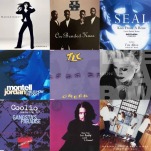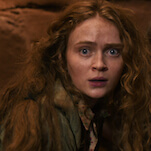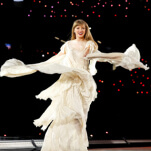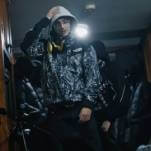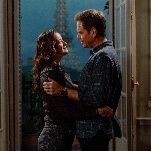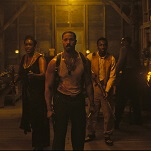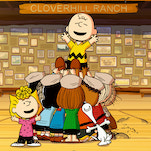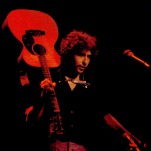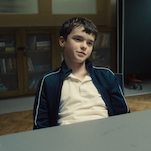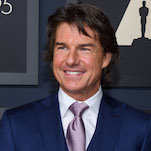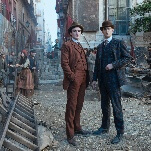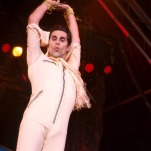I can offer no excuse for having never seen Raging Bull until now. Like the rest of the world, I consider
myself a fan of Martin Scorsese's movies, not to mention a fan of movies in
general, and Raging Bull is
widely considered one of the greatest films of all time. (Just this week, the
AFI declared it the greatest sports movie, edging out Rocky.) Throw your best jab at any list of unmissable
films, and it'll probably be right there near the top.
And it's been sitting on my shelf—along with lots of
other unwatched DVDs—for at least a couple of years. I bought it at
Target for six bucks, assuming that'd be a pretty safe investment based on the
movie's reputation. And while it'd be fun to write a thousand words trying to
take Raging Bull down a peg or two, it'd
also be pretty pointless and baiting. I'm with the herd—Raging
Bull is a classic.
I was happy to have known very little going in—only
that it was a true story about boxer Jake LaMotta, and that Robert De Niro
delivers a Marlon Brando speech ("I could've been a contender") from On The
Waterfront. (Which I also haven't seen!) I
feel like, beyond that, Raging Bull
(which came out in 1980) hasn't really become the sort of cultural touchstone
that it might've: It doesn't have the broad appeal of Rocky, which came out four years earlier, or the
quotability of more popcorn-friendly Scorsese flicks like Goodfellas. In fact, for a movie about explosive violence,
jealousy, and anger, it's often remarkably restrained and subdued. (Until those
scenes that it's not.)
The beautiful, spare title sequence runs in slow motion,
with De Niro stalking a ring alone, with gray shadows and smoke around him,
throwing punches at no one. It's a striking image of a man alone, which De Niro
remains throughout the movie—driving those closest to him away. Then, all
of a sudden, it's 1964, and De Niro is fat and pathetic: He's punch-drunk,
practicing his stand-up comedy routine in front of a dressing-room mirror.
Which reminds me of the other thing that everybody seems to know about Raging
Bull—that De Niro gained 60 pounds
during a three-month break from filming in order to portray the chunky LaMotta
in his declining years.
Just as quickly, it's into the film's first of many fight scenes,
which are incredibly shot and edited. Rarely does the camera move more than a
few feet from the fighters, and both the angles and especially the sound are
nerve-wracking. Constant flashbulbs crackle, their sound effects supposedly
made by breaking glass. It's intense—and not nearly as brutal as the
fights that will happen later, both in the ring and out of it. But the fight
scenes are never fun or invigorating; they're brutal. We meet Joe Pesci,
playing La Motta's brother/manager/cornerman Joey—and the same character
he'll be playing for the next 25 years, essentially. Which isn't to knock
it—it works perfectly here.
It's established early on that De Niro is ugly, mean, and
unlikable—and rarely does Scorsese allow you to sympathize with him. He's
bull-headed at every turn. He's suspicious, jealous, and generally
unpleasant—but with a charm that bubbles up just enough (and a knack for
apologizing). His homelife isn't spared, either. Check out how he treats his
wife in one of the movie's first scenes. He knows a thing or two about cooking
a steak. (And De Niro has that Bronx thing down, well before it became a
cliché.)
Before long, De Niro's eye is caught by 15-year-old Vickie
(played by Cathy Moriarty), who's already wise beyond her years. She's hanging
out by the pool with the mobsters—friends of Jake's brother, but not
his—and teasing everybody. De Niro asks Pesci if he's had sex with her,
and in one of the movie's real-life/real-funny moments, asks Pesci not to swear
so much. (Which they both follow with dozens of "fucks," of course.) "You're a
married man, it's all over," says Pesci. Not so fast.
For a long stretch, Raging Bull doesn't really rage at all. De Niro courts the young
girl, eventually winning her over. He has moments of sweetness—but not
too sweet. After a fight, he tells her, "Touch my boo-boos." (Seconds later,
it's "take off your panties," and then De Niro pours ice-water on his dick.) A
really effective montage (and I'm not a fan of zee montage in general) follows,
with home-movie-styled scenes of their marriage (we never see the divorce from
his current wife) and life together. The happy moments are essentially
fast-forwarded through, and then it's back to the grim reality of being a
prizefighter and a family man. When Moriarty mentions that an upcoming opponent
is good looking, De Niro freaks out, and punishes the other fighter for
something he couldn't have known about. "He ain't pretty no more."
But as his career continues to skyrocket, De Niro gets
lonelier and uglier. He's not having sex (or even going out with) his beautiful
young wife, so she heads off to hang out with mobsters—specifically Frank
Vincent (a.k.a. Phil Leotardo from The Sopranos), who De Niro has always been suspicious of. Pesci, knowing what De
Niro would do if he saw the two even having a drink together, beats the living
shit out of Vincent. (It's something Pesci would be known for in Scorsese's
later films, but he started it here.) Eventually, though, De Niro faces the fact
that—no matter how good a boxer he is—he won't get a title fight
without making a deal with the mobsters he loathes. It's the one instance in
the movie where De Niro does something he doesn't want to do—loses his
raging bull persona—and agrees to fix a fight in order to get a later
title shot. It hurts him more than he imagined it would, and De Niro gives one
of many amazing performances in which he realizes he's in possession of
emotions other than anger.
Two years later, De Niro finally gets his title shot—in
real life, LaMotta not only had to throw the fight, but also pay the mob 20
grand—and absolutely destroys Marcel Cerdan. And even though he's the
champ, he's at an unbelievable low. (It's probably a good time to add that
Scorsese was half-dead from coke before making Raging Bull, and he credits the film and De Niro for pulling him
up from rock bottom.) So it's 1950, Jake is the champ, and he still treats his
two closest allies—wife and brother—like enemies constantly
conspiring against him. When Pesci kisses Moriarty hello, De Niro boils over.
Moriarty, takes the brunt of the abuse, as happens so often
to the female leads in Scorsese's movies—and yet she takes De Niro back
yet again. In a masterful scene, he follows her around—her face visibly
bruised—while she packs her things, convincing her to stay. And then,
finally, we see De Niro get his physical comeuppance. LaMotta fought Sugar Ray
Robinson six times, and the final match—as portrayed by
Scorsese—offers a bloody pinnacle. His face smashed to a pulp, De Niro
never goes down, and he takes that as a victory.
After his defeat, De Niro's LaMotta essentially retires,
replaced in the film by fat De Niro in a 30-minute post-script that finds him
repeatedly fucking up, regretting it, then fucking up again. He's the perfect
actor to play such an imperfect person, and though the film's final
scene—in which he practices his Brando impersonation in a mirror (the
scene was paid tribute in Boogie Nights,
too)—is pretty breathtaking,
I'll leave that a surprise, and leave you with De Niro locked in a cell,
once again realizing that he's not the man he thought he was. It's gorgeous,
horrifying, and masterfully executed—as is the whole movie.

